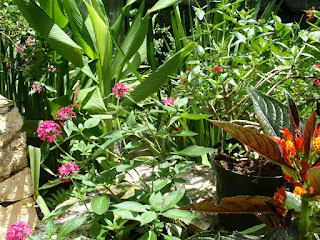



Each week my language school in Copan took an excursion, and in my second week we went to the hot springs. I have to say I was a little skeptical about going. Sometimes some tourist destinations are overrated and I figured the hot springs would be one of them. I've been to some amazing hot springs in Guatemala and I didn't figure these would be anywhere nearly as good.
The springs are located about one hour's drive from Copan on a windy, rough dirt road. There is a public pool (really just a small pool with greenish looking water) on one side which costs $3 though none of us could figure out why anyone would drive all that way to go to those. To get to the 'private' hot springs it costs $10 and you need to cross the river on a wooden suspension type bridge. Despite reading in the MOON guidebook that the private springs had received mixed reviews, everyone I talked to raved about the hot springs and said you MUST cross the bridge to get to the good stuff.
I happen to agree with those who raved about the hot springs. In fact, I wish we'd had more time to spend there. You first cross the bridge with a guide who shows your the various areas you can spend your time. There's a natural 'sauna' area, a spiritual area, a footbath, a small waterfall serving as a shower and neck and shoulder massager, and one area where you slather mud all over your body like at a fancy spa only for free. There's a stone path that takes you to the different areas and apparently you can also schedule massages as there's a massage room directly over the river. The springs are differently temperatures, all pleasant, but there are some areas that are off limits because the water is scaldingly hot. I could see if you had kids you might be concerned about them ignoring the warnings or falling in. In fact, I did hear a story about a Honduran guy who brought two American girls out to the springs at night and fell into the part with the scalding water.
The facilities were lovely and you can tell they are working to improve/add on because there were workers nearby while we were there. It was the raining season, so we could hear thunder while we soaked but because we were so deep in the rain forest, even though it did rain a bit not a drop touched us. Because the hot springs are clearly intended to appeal to tourists, I do wish there'd been some sort of restaurant or cafe on the grounds like the one I'd visited outside of Xela, Guatemala. If that'd been the case, it'd been tough to leave.
If the hot springs seems appealing to you, and you want to extend your trip, the folks who gave the hot springs rave reviews actually visited the hot springs from horseback while staying at
Finca El Cisne . More than one person described their stay at Finca El Cisne as the best part of their time in Honduras. Finca El Cisne is a coffee where you will tour around on horseback guided by the the owner's son (I think that's who he is). The meals are supposed to be awesome. A highly recommended experience. I didn't get to do it but I wish I had...
One more thing--on the way back to Copan we encountered a large truck whose wheel had sunk into wet, muddy road stopping traffic from both directions. We ended up walking the rest of the way. No one was hurt, but I guess this is the hazards of the rainy season, I guess.















